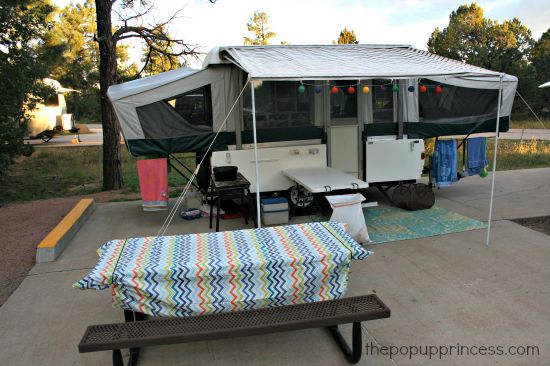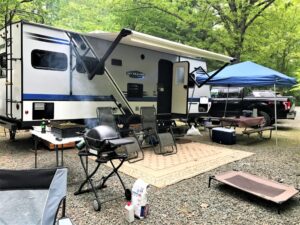Setting up a pop-up campsite involves finding a suitable location, obtaining necessary permits, and providing necessary amenities for campers. Additionally, you’ll need to market your campsite to attract visitors and manage bookings effectively.
This guide will provide you with step-by-step instructions on how to set up a successful pop-up campsite. A pop-up campsite is a temporary camping area that is set up for a specific period, usually during peak camping seasons or special events.
It provides a unique and flexible camping experience for individuals and groups who want to enjoy the great outdoors. Whether you’re a landowner looking to generate additional income or an outdoor enthusiast wanting to share your love for camping, setting up a pop-up campsite can be a rewarding endeavor. By following the right steps and putting in the necessary effort, you can create a memorable camping experience for your guests.

Credit: thepopupprincess.com
Choosing The Perfect Location
Finding the ideal location for your pop-up campsite is crucial to creating a memorable camping experience. The right spot can offer breathtaking views, easy access to attractions, and a sense of tranquility. To ensure you select the perfect location, consider these factors:
Researching Popular Campsites
Before finalizing your decision, take the time to research popular campsites in the area you wish to set up your pop-up campsite. This will give you an understanding of what locations are in high demand and why. Look for reviews and ratings from campers who have visited these sites to get a sense of their experiences.
Consider the following points when researching popular campsites:
- Amenities and facilities provided for campers
- Activities and attractions nearby
- Accessibility for vehicles and pedestrians
- Safety and security measures in place
Factors To Consider In Choosing A Location
When it comes to choosing the perfect location for your pop-up campsite, there are several factors to take into consideration. These factors will help you determine whether a particular spot meets your needs and the needs of your campers. Keep the following points in mind:
- Proximity to attractions: Consider how close the location is to popular attractions, such as hiking trails, lakes, or national parks. Being near these sites will enhance the camping experience for your guests.
- Accessibility: Ensure that the location is easily accessible. Campers should be able to reach your campsite without facing any major obstacles or challenges.
- Privacy: Look for areas that offer seclusion and privacy. Campers often appreciate being able to enjoy the serenity of nature without feeling crowded by other campers.
- Safety: Safety should always be a top priority. Research the area to ensure it is safe from natural hazards like flood-prone areas or animal habitats.
- Environmental impact: Consider the environmental impact of your campsite. Look for locations where you can minimize your ecological footprint and leave the area as pristine as you found it.
By thoroughly researching popular campsites and carefully considering the various factors involved in choosing the perfect location, you’ll be on your way to setting up a successful and enjoyable pop-up campsite.
Essential Equipment And Supplies
How To Set Up A Pop-Up Campsite: Essential Equipment And Supplies
Setting up a pop-up campsite requires careful planning and ensuring you have all the essential equipment and supplies. Whether you are a seasoned camper or new to the outdoors, having the right gear can make your camping experience comfortable and enjoyable.
Let’s take a closer look at the key items you’ll need for your pop-up campsite adventure.
Tent And Shelter Setup
- Choose a tent suitable for the number of people in your group. Look for a tent with enough space for everyone to sleep comfortably.
- Set up your tent on a flat and level surface, preferably on a clear area free of rocks and debris.
- Secure your tent by staking it down to prevent it from being blown away by strong winds.
- Consider using a tarp or footprint underneath your tent to provide extra protection against moisture from the ground.
Sleeping Arrangements
- Invest in comfortable sleeping pads or air mattresses to cushion your body from the hardness of the ground.
- Use warm and durable sleeping bags suitable for the climate you’ll be camping in.
- Bring extra blankets or sleeping bag liners for added warmth during colder nights.
- Pillows, though not a necessity, can make your sleep more comfortable.
Cooking And Food Storage
- Pack a portable camping stove or grill for cooking your meals. Ensure you have enough fuel to last your entire trip.
- Stock up on non-perishable food items like canned goods, granola bars, and dried fruits. Don’t forget to bring cooking utensils, pots, and pans.
- Consider using a cooler or ice chest to keep perishable items like meat, dairy, and fruits fresh.
- Bring plenty of water containers or a water filtration system to ensure you have access to clean drinking water.
Campfire Safety
- Follow the rules and regulations set by the campsite regarding campfires. Check if open fires are allowed and obtain any necessary permits.
- Choose a designated fire pit or create a safe fire ring away from tents and flammable materials.
- Always keep a bucket of water or sand nearby in case of emergencies.
- Never leave the campfire unattended and make sure it is completely extinguished before going to sleep or leaving the campsite.
Bathroom And Hygiene Facilities
- Check if the campsite has existing bathroom facilities like toilets and showers. If not, consider bringing a portable camping toilet and privacy tent.
- Pack biodegradable soap and toiletries to minimize environmental impact.
- In areas where there are no bathing facilities, consider using wet wipes or dry shampoo to stay clean.
- Dispose of waste properly by using designated trash and recycling bins provided by the campsite.
Campsite Lighting
- Bring a reliable flashlight or headlamp for navigating the campsite at night.
- Consider setting up solar-powered lights around your campsite to provide ambient lighting.
- Stringing up battery-operated fairy lights can create a cozy and inviting atmosphere.
- Use lanterns or torches for additional light around cooking and gathering areas.
Remember, when setting up your pop-up campsite, it’s essential to follow the leave no trace principles, respecting nature and leaving the campsite better than you found it. With the right equipment and supplies, your pop-up campsite adventure will be filled with memorable experiences and lifelong memories.
Happy camping!
Setting Up The Campsite
Setting up a pop-up campsite can be an exciting and rewarding experience. It allows you to create a temporary home in the great outdoors, surrounded by nature. When it comes to setting up the campsite, being organized and prepared is key.
Here are some essential steps to follow:
Selecting An Ideal Campsite
- Look for a flat, even ground to ensure a comfortable sleeping and living area.
- Consider the proximity to water sources and bathroom facilities.
- Take into account any regulations or restrictions in the area you’re camping in.
Clearing The Area
- Remove any rocks, sticks, or debris from the campsite to create a clean and safe environment.
- Keep a distance from trees or foliage to minimize the risk of falling branches or insects.
Pitching The Tent And Setting Up Shelter
- Choose a suitable location to pitch your tent, ideally on a level surface.
- Assemble the tent according to the manufacturer’s instructions, ensuring it is properly secured with stakes and guylines.
- Set up additional shelter options like a tarp or canopy for outdoor living space.
Organizing Sleeping Arrangements
- Use sleeping pads or inflatable mattresses for added comfort and insulation.
- Arrange sleeping bags or bedding to suit your preferences.
- Consider using tent dividers or separate tents for privacy.
Building A Safe Campfire
- Select a designated fire ring or cleared area for building a campfire.
- Follow local regulations or campsite rules regarding fires.
- Gather firewood from the surrounding area, ensuring it is dry and suitable for burning.
- Start the fire using kindling and smaller pieces of wood, gradually adding larger logs.
Creating Cooking And Eating Areas
- Set up a camp stove or designated cooking area away from flammable materials.
- Use a sturdy table or surface for food preparation and cooking.
- Keep food storage areas separate from sleeping and living areas to prevent unwanted visits from wildlife.
Setting Up Bathroom Facilities
- If there are no existing bathroom facilities, set up a portable toilet or use established “leave no trace” principles for waste disposal.
- Ensure proper hygiene practices by providing handwashing stations or hand sanitizer.
Establishing Campsite Boundaries
- Define the boundaries of your campsite using natural landmarks or temporary markers like flagging tape.
- Respect neighboring campsites and maintain privacy for both yourself and others.
Securing Your Campsite
- Store food and other scented items in sealed containers or bear-resistant canisters to prevent wildlife encounters.
- Lock away valuables or personal belongings when leaving the campsite unattended.
- Keep a first aid kit readily available and familiarize yourself with its contents.
Remember, the key to setting up a successful pop-up campsite is careful planning, organization, and respect for the natural environment. By following these steps, you’ll be well on your way to enjoying a memorable outdoor adventure.
Frequently Asked Questions For How To Set Up A Pop-Up Campsite?
How Can I Set Up A Pop-Up Campsite?
Setting up a pop-up campsite is easy. Choose a suitable location, set up tents and amenities, and inform campers.
What Are The Essential Items For A Pop-Up Campsite?
For a pop-up campsite, you’ll need tents, sleeping bags, cooking equipment, portable toilets, and lighting.
How Do I Ensure The Safety Of My Pop-Up Campsite?
To ensure safety at your pop-up campsite, check for potential hazards, provide clear instructions, and have a first aid kit on hand.
Can I Make My Pop-Up Campsite Eco-Friendly?
Absolutely! Use eco-friendly products, encourage practices like waste management and recycling, and choose sustainable campsite locations.
Conclusion
Setting up a pop-up campsite can be a rewarding and exciting experience for adventure lovers. By following the right steps, you can create a comfortable and functional space to enjoy the great outdoors. Start by selecting a suitable location that offers amenities and natural beauty.
Next, consider the logistical aspects such as permits, equipment, and facilities. It is crucial to prioritize safety and adhere to any regulations in the area. Simplify your set-up process by organizing and packing essential items, and make sure to dispose of waste responsibly.
Remember to leave no trace and preserve the land’s beauty for future campers. Lastly, embrace the flexibility that pop-up campsites offer and enjoy the freedom of exploring different destinations. With proper planning and attention to detail, your pop-up campsite will provide you with unforgettable memories and a deep connection to nature.

